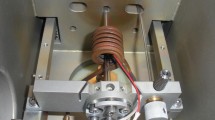Abstract
A high speed gas quenching dilatometer useful in studying phase transformations in low alloy steels is described. Changes in specimen length are measured by means of an electrical micrometer tube. The maximum instantaneous cooling rate is approximately 5000°F per sec; the maximum average cooling rate from 1650° to 950°F is approximately 2900°F per sec. Data for steels of 0.11 pet and 0.67 pet C content are included.
Similar content being viewed by others
References
A.B. Greninger: The Martensite Thermal Arrest in Iron-Carbon Alloys and Plain Carbon Steels. Trans. ASM (1942) 30, p. 1.
P. Chevenard: Mecanisme de la Trempe des Aciers au Carbone. Revue de Metallurgie (1919) 16, p. 17.
A. L. Christenson, E. C. Nelson, and C. E. Jackson: A High-Speed Dilatometer and the Transformational Behavior of Six Steels in Cooling. Trans. AIME (1945) 162, p. 606.
C. L. M. Cottrell: Assessment of Weldability by Rapid Dilatation Tests. Journal Iron and Steel Inst. (1953) 174, p. 17.
C. L. M. Cottrell: Effect of Hydrogen on the Continuous-Cooling Transformation Diagram for a Manganese-Molybdenum Steel. Journal Iron and Steel Inst. (1954) 176, p. 273.
R. W. Dayton and G. M. Foley: Capacitive Micrometer. Electronics (1946) 19, p. 106.
E. J. Vanderman: Microformer Dilatometer. Review of Scientific Instruments (1951) 22, p. 757.
R. Gunn: A Convenient Electrical Micrometer and Its Use in Mechanical Measurements. Journal of Applied Mechanics (1940) 7A, p. 49.
Metals Handbook. (1948) 7th Ed., p. 309. Cleveland. ASM.
A. B. Greninger and A. B. Troiano: Kinetics of the Austenite to Martensite Transformation in Steel. Trans. ASM (1940) 28, p. 537.
S. G. Fletcher and M. Cohen: The Dimensional Stability of Steel. Trans. ASM (1945) 34, p. 227.
M. Cohen: The Martensite Transformation. Phase Transformation in Solids. (1951) p. 605. New York. John Wiley and Sons Inc.
Author information
Authors and Affiliations
Additional information
Discussion of this paper, TP 4063E, may be sent, 2 copies, to AIME by Apr. 1, 1956. Manuscript, Feb. 4, 1955. Philadelphia Meeting, October 1955.
Rights and permissions
About this article
Cite this article
Martin, F.E., Raring, R.H. High Speed Quenching Dilatometer. JOM 8, 191–195 (1956). https://doi.org/10.1007/BF03377673
Published:
Issue Date:
DOI: https://doi.org/10.1007/BF03377673




